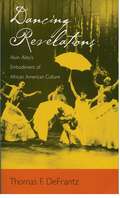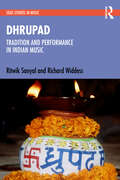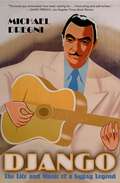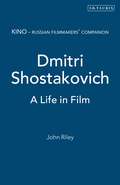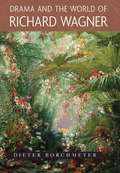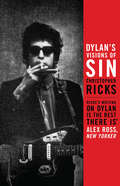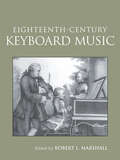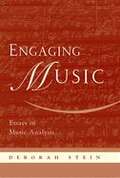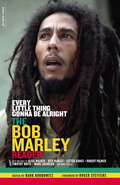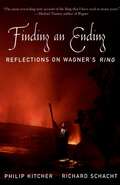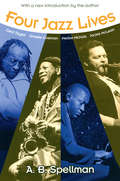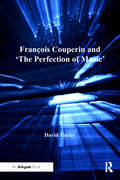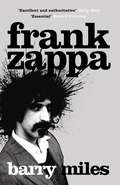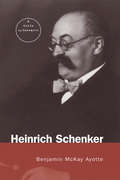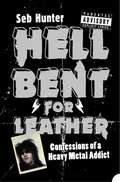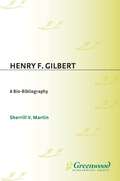- Table View
- List View
Dancing Revelations: Alvin Ailey's Embodiment of African American Culture
by Thomas F. DeFrantzIn the early 1960s, the Alvin Ailey American Dance Theater was a small, multi-racial company of dancers that performed the works of its founding choreographer and other emerging artists. By the late 1960s, the company had become a well-known African American artistic group closely tied to the Civil Rights struggle. In Dancing Revelations, Thomas DeFrantz chronicles the troupe's journey from a small modern dance company to one of the premier institutions of African American culture. He not only charts this rise to national and international renown, but also contextualizes this progress within the civil rights, women's rights, and gay rights struggles of the late 20th century. DeFrantz examines the most celebrated Ailey dances, including Revelations, drawing on video recordings of Ailey's dances, published interviews, oral histories, and his own interviews with former Ailey company dancers. Through vivid descriptions and beautiful illustrations, DeFrantz reveals the relationship between Ailey's works and African American culture as a whole. He illuminates the dual achievement of Ailey as an artist and as an arts activist committed to developing an African American presence in dance. He also addresses concerns about how dance performance is documented, including issues around spectatorship and the display of sexuality, the relationship of Ailey's dances to civil rights activism, and the establishment and maintenance of a successful, large-scale Black Arts institution. Throughout Dancing Revelations, DeFrantz illustrates how Ailey combined elements of African dance with motifs adapted from blues, jazz, and Broadway to choreograph his dances. By re-interpreting these tropes of black culture in his original and well-received dances, DeFrantz argues that Ailey played a significant role in defining the African American cultural canon in the twentieth century. As the first book to examine the cultural sources and cultural impact of Ailey's work, Dancing Revelations is an important contribution to modern dance history and criticism as well as African-American studies.
Der Wahn des Gesamtkunstwerks: Richard Wagners politisch-ästhetische Utopie
by Udo Bermbach"Im Kunstwerk werden wir Eins sein", verheißt Richard Wagner. Leitmotivartig zieht sich dieser Satz durch Wagners Werk und seine Vision einer "ästhetischen Weltordnung". Kunst und Politik werden dabei untrennbar miteinander verwoben. Ein demokratisiertes Publikum soll ein Gesamtkunstwerk erleben, in dem die Einzelkünste zum Musikdrama verschmelzen. Wagner knüpft mit seinem Modell an die antike Polis an, die er idealtypisch in der Moderne wiederbeleben will. In die Neuauflage des revolutionären Wagner-Buchs lässt der Autor weitere überraschende und umfangreiche Analysen u.a. zu Wagners Antisemitismus einfließen.
Dhrupad: Tradition and Performance in Indian Music (SOAS Studies in Music)
by Ritwik Sanyal Richard WiddessDhrupad is believed to be the oldest style of classical vocal music performed today in North India. This detailed study of the genre considers the relationship between the oral tradition, its transmission from generation to generation, and its re-creation in performance. There is an overview of the historical development of the dhrupad tradition and its performance style from the sixteenth to the nineteenth centuries, and of the musical lineages that carried it forward into the twentieth century, followed by analyses of performance techniques, processes and styles. The authors examine the relationship between the structures provided by tradition and their realization by the performer to throw light on the nature of tradition and creativity in Indian music; and the book ends with an account of the ‘revival’ movement of the late twentieth century that re-established the genre in new contexts. Augmented with an analytical transcription of a complete dhrupad performance, this is the first book-length study of an Indian vocal genre to be co-authored by an Indian practitioner and a Western musicologist.
Django: The Life and Music of a Gypsy Legend
by Michael DregniDjango Reinhardt was arguably the greatest guitarist who ever lived, an important influence on Les Paul, Charlie Christian, B.B. King, Jerry Garcia, Chet Atkins, and many others. Yet there is no major biography of Reinhardt. Now, in Django, Michael Dregni offers a definitive portrait of this great guitarist. Handsome, charismatic, childlike, and unpredictable, Reinhardt was a character out of a picaresque novel. Born in a gypsy caravan at a crossroads in Belgium, he was almost killed in a freak fire that burned half of his body and left his left hand twisted into a claw. But with this maimed left hand flying over the frets and his right hand plucking at dizzying speed, Django became Europe's most famous jazz musician, commanding exorbitant fees--and spending the money as fast as he made it. Dregni not only chronicles this remarkably colorful life--including a fascinating account of gypsy culture--but he also sheds much light on Django's musicianship. He examines his long musical partnership with violinist Stéphane Grappelli--the one suave and smooth, the other sharper and more dissonant--and he traces the evolution of their novel string jazz ensemble, Quintette du Hot Club de France. Indeed, the author spotlights Django's amazing musical diversity, describing his swing-styled Nouveau Quintette, his big band Django's Music, and his later bebop ensemble, as well as his many compositions, including symphonic pieces influenced by Ravel and Debussy and his unfinished organ mass inspired by Bach. And along the way, the author offers vivid snapshots of the jazz scene in Paris--colorful portraits of Josephine Baker, Bricktop, Louis Armstrong, Coleman Hawkins, and countless others--and of Django's vagabond wanderings around France, Europe, and the United States, where he toured with Duke Ellington. Capturing the extraordinary life and times of one of the great musicians of the twentieth century, Django is a must-read portrait of a true original.
Dmitri Shostakovich: A Life in Film (KINO - Russian Filmmakers' Companions)
by John RileyOf all the major Soviet composers who worked in the cinema, the most prominent was Dmitri Shostakovich who, in addition to over a hundred works for the stage and concert hall, wrote scores for almost forty films. Yet despite his reputation this work, when not completely overlooked, has been poorly judged by the same criteria as his other music. Likewise, while much attention has been paid to Soviet film, the crucial role played by the scores is all too often forgotten. This, the first book in English to look at Shostakovich's cinema career, discusses every film he scored, looking at the films themselves, tracing their relationship to the changing concerns and policies of the Soviet state and examining how the music works in context. John Riley also gives a fascinating account of the composer's life. This highly readable book will be welcomed equally by devotees of the composer; those interested in Soviet culture and cinema; and general film music enthusiasts.
Drama and the World of Richard Wagner (PDF)
by Dieter Borchmeyer Daphne EllisRichard Wagner continues to be the most controversial artist in history, a perpetually troubling figure in our cultural consciousness. The unceasing debate over his works and their impact--for and against--is one reason why there has been no genuinely comprehensive modern account of his musical dramas until now. Dieter Borchmeyer's book is the first to present an overall picture of these musical dramas from the standpoint of literary and theatrical history. It extends from the composer's early works--still largely ignored--to the Ring Cycle and Parsifal, and includes Wagner's unfinished works and operas he never set to music. Through lively prose, we come to see Wagner as a librettist--and as a man of letters--rather than primarily as musical composer.Borchmeyer uncovers a vast field of cultural and historical cross-references in Wagner's works. In the first part of the book, he sets out in search of the various archetypal scenes, opening up the composer's dramatic workshop to the reader. He covers all of Wagner's operas, from early juvenilia to the canonical later works.The second part examines Wagner in relation to political figures including King Ludwig II and Bismarck, and, importantly, in light of critical reactions by literary giants--Thomas Mann, whom Borchmeyer calls "a guiding light in this exploration of the fields that Wagner tilled," and Nietzsche, whose appeal to "philology" is a key source of inspiration in attempts to grapple with Wagner's works.For more than twenty years, Borchmeyer has placed his scholarship at the service of the famed Bayreuth Festival. With this volume, he gives us a summation of decades of engagement with the phenomenon of Wagner and, at the same time, the result of an abiding critical passion for his works.
Dylan's Visions of Sin
by Christopher Ricks‘I consider myself a poet first and a musician second’ ‘It ain’t the melodies that’re important man, it’s the words’ Two quotes from Dylan himself that underline the importance of this book. Dylanology thrives. There is no shortage of books about him and many of them will be dusted off for his 70th birthday. This one, however, stands on its own both for its unusual approach and for the virtuosity of its execution. Ricks’s scheme, aptly, is to examine Dylan’s songs through the biblical concepts of the seven deadly Sins, the four Virtues, and the three Heavenly Graces. He carries it off with panache. Ricks may be the most eminent literary critic of his generation but nobody should feel his book is one of earnest, unapproachable exegesis, on the contrary it has a flamboyance, almost effervescence about it that is captivating. Ricks boldly and successfully judges Dylan as a poet not a lyricist and in his tour-de-force makes endless illuminating comparisons with canonical writers such as Eliot, Hardy, Hopkins and Larkin.
Eighteenth-Century Keyboard Music
by Robert MarshallFirst published in 2004. Routledge is an imprint of Taylor & Francis, an informa company.
Eighteenth-Century Keyboard Music
by Robert L. MarshallFirst published in 2004. Routledge is an imprint of Taylor & Francis, an informa company.
Every Little Thing Gonna Be Alright: The Bob Marley Reader
by Hank BordowitzThroughout Africa, the Caribbean, Europe, and America, Bob Marley represents far more than just the musician who translated spiritual and political beliefs into hypnotic, hard-hitting songs such as "Get Up, Stand Up," "No Woman, No Cry," and "Jammin'." Marley was born in rural Jamaica and reared in the mean streets of Kingston's Trenchtown; his ascent to worldwide acclaim, first with The Wailers--Peter Tosh and Bunny Livingstone--and later as a solo artist, is a riveting story of the spiritual awakening of a uniquely talented individual.Now, for the first time, a symphony of voices has joined together to offer perspective on one of this century's most compelling figures. Dealing with Bob Marley as a man and myth, from his "rude boy" teens to international fame and his tragic death at the age of thirty-six, Every Little Thing Gonna Be Alright then explores the larger picture, examining Marley as the spokesman for Jamaica's homegrown religion of Rastafarianism, as a flash point for the pressure cooker of Jamaican politics, and his unique status as the first pop musical superstar of the so-called "Third World."
Every Little Thing Gonna Be Alright: The Bob Marley Reader
by Hank BordowitzThroughout Africa, the Caribbean, Europe, and America, Bob Marley represents far more than just the musician who translated spiritual and political beliefs into hypnotic, hard-hitting songs such as "Get Up, Stand Up," "No Woman, No Cry," and "Jammin'." Marley was born in rural Jamaica and reared in the mean streets of Kingston's Trenchtown; his ascent to worldwide acclaim, first with The Wailers--Peter Tosh and Bunny Livingstone--and later as a solo artist, is a riveting story of the spiritual awakening of a uniquely talented individual.Now, for the first time, a symphony of voices has joined together to offer perspective on one of this century's most compelling figures. Dealing with Bob Marley as a man and myth, from his "rude boy" teens to international fame and his tragic death at the age of thirty-six, Every Little Thing Gonna Be Alright then explores the larger picture, examining Marley as the spokesman for Jamaica's homegrown religion of Rastafarianism, as a flash point for the pressure cooker of Jamaican politics, and his unique status as the first pop musical superstar of the so-called "Third World."
Finding an Ending: Reflections on Wagner's Ring
by Philip Kitcher Richard SchachtFew musical works loom as large in Western culture as Richard Wagner's four-part Ring of the Nibelung. In Finding an Ending, two eminent philosophers, Philip Kitcher and Richard Schacht, offer an illuminating look at this greatest of Wagner's achievements, focusing on its far-reaching and subtle exploration of problems of meanings and endings in this life and world. Kitcher and Schacht plunge the reader into the heart of Wagner's Ring, drawing out the philosophical and human significance of the text and the music. They show how different forms of love, freedom, heroism, authority, and judgment are explored and tested as it unfolds. As they journey across its sweeping musical-dramatic landscape, Kitcher and Schacht lead us to the central concern of the Ring--the problem of endowing life with genuine significance that can be enhanced rather than negated by its ending, if the right sort of ending can be found. The drama originates in Wotan's quest for a transformation of the primordial state of things into a world in which life can be lived more meaningfully. The authors trace the evolution of Wotan's efforts, the intricate problems he confronts, and his failures and defeats. But while the problem Wotan poses for himself proves to be insoluble as he conceives of it, they suggest that his very efforts and failures set the stage for the transformation of his problem, and for the only sort of resolution of it that may be humanly possible--to which it is not Siegfried but rather Brünnhilde who shows the way. The Ring's ending, with its passing of the gods above and destruction of the world below, might seem to be devastating; but Kitcher and Schacht see a kind of meaning in and through the ending revealed to us that is profoundly affirmative, and that has perhaps never been so powerfully and so beautifully expressed.
Four Jazz Lives: Four Jazz Lives (Jazz Perspectives)
by A. B. SpellmanReview "Remains the best introduction to the worlds of Cecil Taylor, Ornette Coleman, Herbie Nichols, and Jackie McLean." --Ben Ratliff --Ben Ratliff (10/31/2003) "Four black jazzmen speak at considerable length for themself, with connective passages supplied with persistent relevancy by a poet, historian, and critic." --Nat Hentoff --Nat Hentoff (10/31/2003) "An essential book in the jazz canon. . . . [T]he University of Michigan Press has given it a rebirth under the title Four Jazz Lives." --Nat Hentoff, JazzTimes -- (07/29/2004) "An engrossing, impressionistic history of contemporary jazz." --Nation --Nation (10/31/2003) "[Spellman] views these men with a perceptive and understanding eye." --New York Times --New York Times (10/31/2003) About the Author A. B. Spellman is a well-known author, poet, critic, and instructor. He has published numerous books and articles on the arts, including Art Tatum: A Critical Biography and The Beautiful Days.
François Couperin and 'The Perfection of Music'
by David TunleyFrançois Couperin's contribution to the literature of baroque keyboard music has long been recognized. François Couperin and 'The Perfection of Music' updates and expands upon David Tunley's valuable 1982 BBC Music Guide to the composer, and examines the whole of Couperin’s output including the organ masses, motets and chamber music, in addition to the well-known works for harpsichord. Taking as its focal point Couperin's concept of the perfection of music through the union of the French and Italian styles, this book takes a more analytical approach to Couperin's work. Early chapters outline the main contrasting features of the two schools in the seventeenth- and early eighteenth-centuries, and it becomes clear that Couperin's expressive power owed much to his fusion of the polarities of the French classical tradition with that of the Italian baroque. The book features a number of appendices, including the prefaces to Couperin's work both in the original French and in English translation, and a glossary of dances of the French baroque.
François Couperin and 'The Perfection of Music'
by David TunleyFrançois Couperin's contribution to the literature of baroque keyboard music has long been recognized. François Couperin and 'The Perfection of Music' updates and expands upon David Tunley's valuable 1982 BBC Music Guide to the composer, and examines the whole of Couperin’s output including the organ masses, motets and chamber music, in addition to the well-known works for harpsichord. Taking as its focal point Couperin's concept of the perfection of music through the union of the French and Italian styles, this book takes a more analytical approach to Couperin's work. Early chapters outline the main contrasting features of the two schools in the seventeenth- and early eighteenth-centuries, and it becomes clear that Couperin's expressive power owed much to his fusion of the polarities of the French classical tradition with that of the Italian baroque. The book features a number of appendices, including the prefaces to Couperin's work both in the original French and in English translation, and a glossary of dances of the French baroque.
Frank Zappa: A Biography
by Barry MilesBarry Miles knew Frank Zappa intimately and was present at the recording of some of his most important albums. This sparkling biography brings the Zappa the musician and composer, Zappa the controversialist and Zappa the family man (despite his love of groupies, he was married for more than 30 years) together for the first time. Barry Miles' biography follows Zappa from his sickly Italian-American childhood in the 1940s (when his father, Frank senior, worked for the US military and was used to test the efficacy of new biological warfare agents) to his death from cancer in the 1990s. Miles shows how Zappa's goal had been to become a classical composer, until he realised that he would starve to death pursuing this ambition in post-war America. In an effort to make music people would actually listen to, in the mid-1960s he joined a noisy new band called 'The Mothers of Invention'. Before long, Zappa had taken over as singer, song writer and lead guitarist and together they exploded on to the San Francisco freak scene. Following the release of recordings such as Freak Out, Absolutely Free, We're Only In It For the Money and Hot Rats, Zappa's reputation in the United States and in Europe, especially the UK, Germany and Holland, took off. When the Berlin wall fell, Frank was surprised to learn that his extravagant music embodied sixties liberty for a generation of dissidents (including Vaclav Havel, who invited Zappa to be his minister for culture). Frank Zappa is an authoritative and hugely enjoyable portrait of a singular man and a vivid evocation of the West Coast scene.
Gene Vincent & Eddie Cochran: Rock N Roll Revolutionaries
by John CollisThe United Kingdom had never seen anything like it, as two rock'n'roll legends rampaged around the country on Britain's first-ever rock tour. Gene Vincent and Eddie Cochran lived the rock'n'roll lifestyle to the full, bringing to an end the monochrome 1950s and ushering in the swinging 60s.John Collis has traced the story of the UK tour that was a defining moment in British popular culture to its tragic climax with the death of Eddie Cochran. He looks back on the contrasting backgrounds of the two stars, follows the tale onwards to Gene Vincent's death from alcohol and drug abuse, and examines the lasting legacy of their music.
Health, the Individual, and Integrated Medicine: Revisiting an Aesthetic of Health Care (PDF)
by David AldridgeHow do we decide on the most effective way to heal ourselves or our patients? Complementary therapies are a vital part of any integrated approach to health which incorporates specialist and layperson knowledge. In this book, David Aldridge examines cultural understandings of illness and medicines. He provides a critique of orthodox methods used to assess treatment, and advocates a more pluralistic approach to medical research and practice, encompassing the physical, psychological, spiritual and social dimensions of a person's life. To assess medical research in a range of situations, Aldridge examines how asthma can be treated by acupuncture, how communities cope with terminal cancer and how music therapy and spiritual healing can be used. In a positive move to improve current healthcare systems, Aldridge suggests guidelines for medical education and research. Doctors and other healthcare professionals, academics, students and people undergoing treatment themselves will be inspired by this direct, thoughtful and practical guide to research in current healthcare practice. David Aldridge is the author of a number of books within related fields such as Spirituality, Healing and Medicine: Return to the Silence and Music Therapy Research and Practice in Medicine, both published by Jessica Kingsley Publishers.
Heinrich Schenker: A Research and Information Guide
by Benjamin AyotteThis book consists of over 1,500 citations to both primary sources and the burgeoning secondary literature of Heinrich Schenker, annotated and subdivided by category. The citations are supplemented with indices cross-referencing entries according to individual works and analytical topic.
Heinrich Schenker: A Research and Information Guide
by Benjamin AyotteThis book consists of over 1,500 citations to both primary sources and the burgeoning secondary literature of Heinrich Schenker, annotated and subdivided by category. The citations are supplemented with indices cross-referencing entries according to individual works and analytical topic.
Hell Bent for Leather: Confessions Of A Heavy Metal Addict (P. S. Ser.)
by Seb HunterA witty and self-deprecating memoir about headbanging your way through growing up.
Henry F. Gilbert: A Bio-Bibliography (Bio-Bibliographies in Music)
by Sherrill MartinDuring his lifetime, Henry F. Gilbert was regarded as one of the foremost composers of the day and a trailblazer in America's rich musical heritage. Often called the Mark Twain of American Music, Gilbert was one of American music's nonconformists. He was a maverick who became a true prophet of American music as a composer, writer, editor, and lecturer. This volume contains a short biography of Gilbert, a listing of his compositions, including the different versions of the works and the holding libraries. A discography is included, which puts emphasis on the inclusion of excerpts from contemporary performances. This book captures much of the new material on Gilbert that has surfaced since the Henry F. Gilbert Papers were presented to Yale.The volume is divided into six sections. The first is the biography, which includes a sketch of Gilbert's life, and his importance in establishing an American school of composition. The Works and Performances section provides the name of the work, publisher, and date and revisions of the work. Scoring for the compositions is also given along with cross-references to Gilbert's program notes and reviews. An annotated Bibliography of writings by Gilbert summarizes his philosophy of American music, and illuminates his own compositional style. A discography, general bibliography, and a bibliography of works and performances are also concluded. This bio-bibliography will appeal to musicians and American enthusiasts alike.
Hollywood Theory, Non-Hollywood Practice: Cinema Soundtracks in the 1980s and 1990s
by Annette DavisonRelatively little has been written about film scores and soundtracks outside of Hollywood cinema. Hollywood Theory, Non-Hollywood Practice addresses this gap by looking at the practices of film soundtrack composition for non-Hollywood films made after 1980. Annette Davison argues that since the mid-1970s the model of the classical Hollywood score has functioned as a form of dominant ideology in relation to which alternative scoring and soundtrack practices may assert themselves. The first part of the book explores some of the key theoretical issues and debates in film studies and film music studies. The second part comprises a series of case studies of non-Hollywood scores. Starting with Jean Luc Godard's Pr m: Carmen (1983), Davison argues that the film's score offers a deconstruction of the relationship between sound and image proposed by classical Hollywood film. Derek Jarman's The Garden (1990) takes the debate a step further in its exploration of the possibility that a film's soundtrack may be liberated from slavery to the image track. Wings of Desire (1987) directed by Wim Wenders offers, Davison believes, a negotiation between classical and alternative scoring and soundtrack practices; while David Lynch's Wild at Heart (1990) actually fully integrates scoring and soundtrack practices so that sounds and dialogue are used in musical ways. Seeking to stimulate debate about the aesthetics and interpretation of film scores and soundtracks in general, this book develops an important synthesis of film studies and musicology.
Hollywood Theory, Non-Hollywood Practice: Cinema Soundtracks in the 1980s and 1990s
by Annette DavisonRelatively little has been written about film scores and soundtracks outside of Hollywood cinema. Hollywood Theory, Non-Hollywood Practice addresses this gap by looking at the practices of film soundtrack composition for non-Hollywood films made after 1980. Annette Davison argues that since the mid-1970s the model of the classical Hollywood score has functioned as a form of dominant ideology in relation to which alternative scoring and soundtrack practices may assert themselves. The first part of the book explores some of the key theoretical issues and debates in film studies and film music studies. The second part comprises a series of case studies of non-Hollywood scores. Starting with Jean Luc Godard's Pr m: Carmen (1983), Davison argues that the film's score offers a deconstruction of the relationship between sound and image proposed by classical Hollywood film. Derek Jarman's The Garden (1990) takes the debate a step further in its exploration of the possibility that a film's soundtrack may be liberated from slavery to the image track. Wings of Desire (1987) directed by Wim Wenders offers, Davison believes, a negotiation between classical and alternative scoring and soundtrack practices; while David Lynch's Wild at Heart (1990) actually fully integrates scoring and soundtrack practices so that sounds and dialogue are used in musical ways. Seeking to stimulate debate about the aesthetics and interpretation of film scores and soundtracks in general, this book develops an important synthesis of film studies and musicology.
